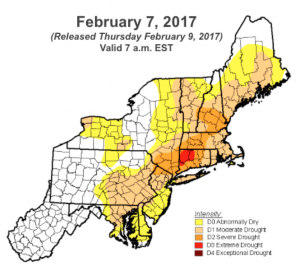I love any excuse to come to New York — when it’s not February. — K. A. Applegate
Ahh, February. The Monday of months. Yet even with a foot of snow on the ground over most of New York, you can take steps now for a healthy lawn.

First, be grateful for the snow — and add more to your wish list. The Northeast Regional Climate Center notes that much of New York is still in a drought. We’ll check next week to see how the February 9 snowstorm affects the readings, but The New York City reservoir system was at 77.6% of capacity on February 8 compared to normal capacity of 87.8%. We still have a ways to go to make up the deficit.
Second, now is a great time for learning and planning. The new and improved Cornell Turfgrass website has a section dedicated to home lawns and includes:

- Lawn Care: The Easiest Steps to an Attractive Environmental Asset -available as an ebook on iTunes and as a website. This resource includes information on basic and advanced care of lawns, how to renovate, choosing the right seed, dealing with salt (whether it comes from deicing products or your dog), and even tips on hiring a lawn care professional if that is your preference. Videos and photo galleries are included.
- Turfgrass Species and Variety Guidelines for NYS – If you want to get deeper into the science of seed selection, then this is the resource for you. Different types of turfgrass are adapted to different soil, light, and traffic conditions. Choosing the right type will help you maintain the best lawn with the least amount of inputs such as irrigation, fertilizer, and pesticides.

Cornell University turfgrass expert Dr. Frank Rossi narrates this short how-to video on sharpening your mower blade.
Third, the single most important lawn care practice you can undertake for a healthy lawn is proper mowing — and now is a great time to sharpen those blades. Why bother? Dull blades:
- shred rather than cut grass
- stress your lawn, making it …
- more susceptible to insects, diseases, and drought
- increase fuel use by up to 20%
For DIYers, the Lawn Care: The Easiest Steps to an Attractive Environmental Asset website has a video on blade sharpening. Or beat the crowds: take your mower to a repair shop for a tune-up before mowing season hits.
Fourth, the ongoing drought left many poorly or non-irrigated lawns a little thin. Overseeding helps fill in the bare spots. You don’t even need to wait until spring. Dormant overseeding over the next few weeks can help you get a head start on the season. Use the resources above to choose a drought-tolerant turfgrass type, so watch the forecast and try to get out ahead of the next snowstorm.
February is short, so take advantage of this time to prepare for your best lawn yet. Learn more at IPM for Landscapes, Parks & Golf Courses.